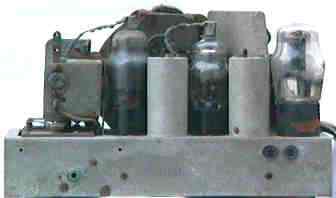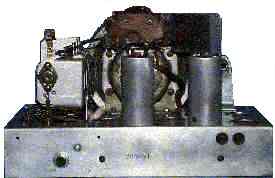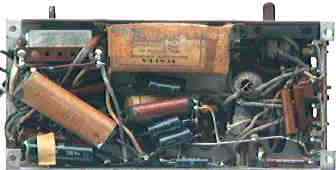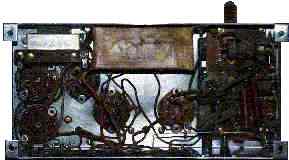

Unrestored front
Restored
chassis
The wiring of this Sonora Sonorette
matches Model 855D (schematic).
The radio originates from 1933 and its housing is a wooden
cabinet with the measures (hxwxd) 19x29x13.5 cm.
Model 855D is a superheterodyne receiver, employs 5 tubes (6A7,
78, 77, 43 and 25Z5), has an IF of 135 kHz and covers two bands.
The mains voltage is 110 Volt and rectified by the 25Z5
(tranformerless). The 110 Volt AC is also supplied, via a
powerline cord of 160 ohm, to a series connection of the
filaments of the 5 tubes.
 
Chassis before and after restoration (tubes
not yet put back in place).
 
Bottom side of chassis before and after
restoration (not all components put on place yet).
The radio (acquired on a radio flea market) had the following
main defects:
1. open winding in filter inductor
2. volume potentiometer (50 kohm) burnt out
3. electrolytic capacitors in bad shape
4. various resistors and capacitors off-value
5. dirt, dust, rust everywhere .........
As the chassis was in a bad shape (a.o. rust), I dismantled the
radio until the last screw and piece of wire. The chassis was
cleaned thoroughly and thereafter zinc-plated in a local
workshop.
The open-circuit in the filter inductor appeared to be caused by
a corroded junction of the connecting wire at the last winding of
the inductor. The inductor body was provided with complete new
windings (total resistance 310 ohm; originally 350 ohm).
The volume potentiometer was replaced by a rather similar
potmeter of 50 kohm out of my junk-box.
The IF-transformers were dismantled and cleaned and the tuning
capacitor, trimmers and band switch got the same treatment.
As all electrolytic, paper and mica capacitors were lossy and/or
leaky, they were replaced. This was accomplished by emptying the
respective housings, placing new high quality components in the
original housings and sealing the housings again with a dark
grey, kneadable two-component epoxy. This material hardened after
5 to 10 minutes after mixing the two components by kneading.
Most resistors had increased resistance values. As I had no
resistors available of the same type, I left the original
resistors in their place and connected a new resistor of an
appropriate value parallel to the original ones in those cases
where the original resistors were too far off-value.
Radio has been sold and is no longer part of my
collection.
|

